Child safety
Child safety
General information
Carrying children
Please ensure that you comply with the legislation of your country.
Children, and adults, must be correctly seated and strapped in for all journeys. The
children being carried in your vehicle are your responsibility.
A child is not a miniature adult. Children are at risk of specific injuries as their
muscles and bones have not yet finished growing. The seat belt alone would not provide
suitable protection. Use an approved child seat and ensure you use it correctly.
WARNING
To prevent the doors being opened, use the "Child lock" feature OPENING AND CLOSING THE DOORS.
WARNING
A collision at 31 mph (50 km/ h) is the same as falling a distance of 10 metres.
Transporting a child without a restraint is the equivalent of allowing him or her
to play on a fourth-floor balcony without railings.
Never travel with a child held in your arms.
In the event of an accident, you will not be able to keep hold of the child, even
if you yourself are wearing a seat belt.
If your vehicle has been involved in a road accident, replace the child seat and have
the seat belts and ISOFIX anchorage points checked.
WARNING
Driver's responsibility when parking or stopping the vehicle
Never leave an animal, child or adult who is not self-sufficient alone in your vehicle,
even for a short time.
They may pose a risk to themselves or to others by starting the engine, activating
equipment such as the electric windows or by locking the doors.
Also, in hot and/or sunny weather, please remember that the temperature inside the
passenger compartment increases very quickly.
RISK OF DEATH OR SERIOUS INJURY.
Using a child seat
The level of protection offered by the child seat depends on its ability to restrain
your child and on its installation. Incorrect installation compromises the protection
it offers the child in the event of harsh braking or an impact.
Before purchasing a child seat, check that it complies with the regulations for the
country you are in and that it can be fitted in your vehicle. Consult an approved
Dealer to find out which seats are recommended for your vehicle.
The regulations on transporting children are specific to each country. The use of
a child seat during transport depends on the age and/or the size and/or weight of
the child.
For children who do not need to be transported in a child seat, make sure that the
seat belt is correctly adjusted and fastened.
In all cases, you must comply with the regulations of the particular country you are
in.
Before fitting a child seat, read the manual and respect its instructions. If you
experience any difficulties during installation, contact the manufacturer of the equipment.
Keep the instructions with the seat.
Tip
Set a good example by always fastening your seat belt and teaching your child:
- to strap themselves in correctly;
- to always get in and out of the car at the kerb, away from busy traffic.
Do not use a second-hand child seat or one without an instruction manual.
Check that there are no objects in the vicinity of the child seat which could impede
its operation.
WARNING
Never leave a child unattended in the vehicle.
Check that your child is always strapped in and that the belt or safety harness used
is correctly set and adjusted. Avoid wearing bulky clothing which could cause the
belts to slacken SEAT BELTS.
Never let your child put their head or arms out of the window.
Check that the child is in the correct position for the entire journey, especially
if asleep.
Choosing a child seat
Rear-facing child seats
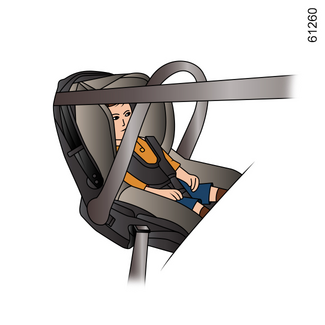
A baby’s head is, proportionally, heavier than that of an adult and its neck is very
fragile. Transport the child in this position as long as possible (until the age of
2 at the very least). It supports both the head and the neck.
Choose a bucket type seat for best side protection and change it as soon as the child’s
head is higher than the shell.
Forward-facing child seats
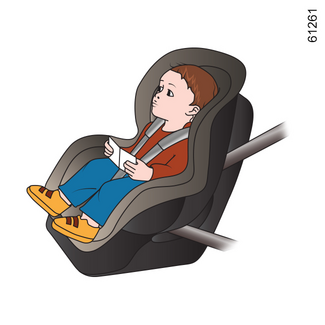
Up to 18 kg or 4 years, the child may travel on a forward-facing seat. Choose your
seat according the child's size: their head and abdomen are the areas which must be
most protected. A forward-facing child seat which is firmly attached to the vehicle
will reduce the risk of impact to the head. Ensure your child travels in a forward-facing
seat with a harness for as long as their size permits.
Choose a bucket type seat for optimum side protection.w
Booster cushions
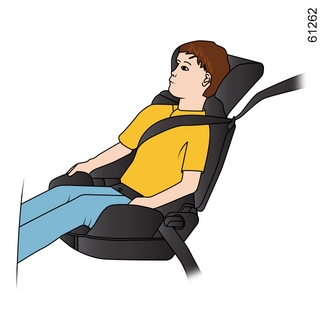
From 15 kg or 4 years, the child can travel using a booster seat, which will enable
the seat belt to be adapted to suit his size and shape. The booster seat cushion must
be fitted with guides to position the seat belt on the child’s thighs rather than
the stomach. It is recommended that you use a seatback which can be adjusted in terms
of height to position the seat belt in the centre of the shoulder. It must never rest
on the neck or on the arm.
Choose a bucket type seat for optimum side protection.w
Choosing a child seat mounting
There are two ways to attach child seats: using the seat belt or using the ISOFIX system.
Attachment via the seat belt
The seat belt must be adjusted in order to ensure it works in the event of sudden
braking or impact.
Ensure that the strap paths indicated by the child seat manufacturer are observed.
Always check that the seat belt is correctly fastened by pulling it up, then pulling
it out fully whilst pressing on the child seat.
Check that the seat is correctly held by moving it from side to side and back to front:
the seat should remain firmly fixed.
Check that the child seat has not been installed at an angle and that it is not resting
against a window.
WARNING
Do not use the child seat if it risks unfastening the seat belt restraining it: the
base of the seat must not rest on the buckle and/or catch of the seat belt.
WARNING
The seat belt must never be twisted or the tension relieved.
Never pass the shoulder strap under the arm or behind the back.
Check that the seat belt has not been damaged by sharp edges.
If the seat belt does not operate normally, it will not protect the child.
Consult an approved dealer.
Do not use this seat until the seat belt has been repaired.
Attachment using the ISOFIX system
Authorised child seats ISOFIX are approved in accordance with current regulations if any of the four cases below
applies:
- Universal ISOFIX 3-point forward-facing seat;
- Semi-universal ISOFIX 2-point seat;
- vehicle-specific;
- i-Size which has either:
- a strap which attaches to the third ring of the seat concerned;
- or a strut that rests on the vehicle floor, compatible with the approved seat i-Size, the role of which is to prevent the child seat from moving in the event of a collision.
In the latter three cases check that your child seat can be installed by consulting
the list of compatible vehicles.
WARNING
No modifications must be made to the component parts of the originally fitted restraint
system (seat belts, ISOFIX, seats and their mountings).
Attach the child seat with the ISOFIX locks, if these are provided. The ISOFIX system allows quick, easy and safe fitting.
The ISOFIX system consists of two rings and, in some cases, a third ring.
WARNING
The ISOFIX anchorage points have been exclusively designed for child seats with the ISOFIX system.
Never fit a different type of child seat, seat belt or other objects to these fittings.
Check that nothing is obstructing the anchorage points.
If your vehicle has been involved in a road accident, have the ISOFIX anchorage points checked and replace your child seat.
WARNING
Before using an ISOFIX child seat that you purchased for another vehicle, check that its installation is
authorised. Consult the list of vehicles which can be fitted with the seat with the
equipment manufacturer.

The two rings 1 are located between the seatback and the seat base and are identified by a  mark.
mark.
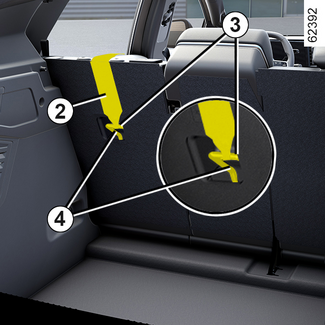
The third ring 4 is used to attach the upper strap on some child seats. 2 on some child seats.
Rear seats
The upper strap 2 should be positioned between the seatback and the rear parcel shelf. To do so, remove
the rear parcel shelf LUGGAGE COMPARTMENT REAR PARCEL SHELF.
Attach the hook 3 to one of the rings 4 marked by the  symbol.
symbol.
Front passenger seat
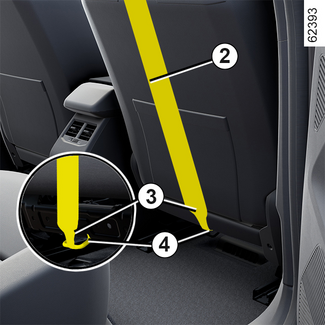
Attach the hook 3 of the upper strap 2 to the ring 4 identified by the  symbol.
symbol.
All seats
Pull the upper strap 2 so that the back of the child seat comes into contact with the back of the vehicle
seat.
WARNING
The ISOFIX anchorage points have been exclusively designed for child seats with the ISOFIX system. Never fit a different type of child seat, seat belt or other objects to these
fittings.
Check that nothing is obstructing the anchorage points.
If your vehicle has been involved in a road accident, have the ISOFIX anchorage points checked and replace your child seat.
WARNING
Check that the seatback of the forward-facing child seat is in contact with the seatback
of the vehicle seat. In this case, the child seat may not always rest on the seat
base of the vehicle seat.
WARNING
The child seat strap must be attached to the corresponding ring.
Fitting a child seat, general information
Some seats are not suitable for fitting child seats.
The diagrams on pages CHILD SEATS show you how to attach a child seat.
WARNING
Fit the child seat in a rear seat wherever possible.
Make sure the child seat or the child's feet do not prevent the front seat from locking
correctly FRONT SEATS WITH MANUAL CONTROL.
Check that when installing the child seat in the vehicle it is not at risk of coming
loose from its base.
If you have to remove the headrest, check that it is correctly stored so that it does
not come loose under harsh braking or impact.
Always attach the child seat to the vehicle even if it is not in use so that it does
not come loose under harsh braking or impact.
The types of child seats indicated may not be available. Before using a different
child seat, check with the manufacturer that it can be fitted.
In the front seat
The laws concerning children travelling in the front passenger seat differ in every
country. Consult the relevant legislation and follow the indications on the diagram.
Before fitting a child seat in this seat (if authorised):
- lower the seat belt as far as possible;
- move the seat as far back as possible;
- gently tilt the seatback away from the vertical position (approximately 25°);
- on equipped vehicles, raise the seat base as far as possible.
Always fully raise the seat headrest so that it does not interfere with the child
seat FRONT HEADRESTS.
After installing the child seat, when this is possible, you can move the vehicle seat
forward if necessary (so as to leave enough space in the rear seats for passengers
or other child seats). For a rear-facing child seat, do not let it touch the dashboard
or move it to the furthest forward position.
Do not change other settings after installing the child seat.
WARNING
RISK OF DEATH OR SERIOUS INJURY: after fitting a rear-facing child seat in this seat, make sure that the airbag has been deactivated PASSENGER DETECTION SYSTEMCHILD SAFETY.
In the rear side seat
A carrycot can be installed across the vehicle and will take up at least two seats.
Position the child with his or her feet nearest the door.
In order to install a rear-facing child seat, move the front seat as far forward as
possible, then move the front seat back as far as it will go, without allowing it
to come into contact with the child seat.
For the safety of the child in the forward-facing position:
- move the seat in which the child will be seated as far back as possible;
- Move the seat in front of the child forwards, and set the position of the seatback to avoid contact between the seat and the child's legs.
WARNING
Make sure the child seat or the child's feet do not prevent the front seat from locking
correctly FRONT SEATS WITH MANUAL CONTROL.
In all situations, remove the headrest of the rear seat on which the child seat is
positioned REAR HEADRESTS. If necessary, position the rear seat as far back as possible. This must be done
before fitting the child seat. Check that the child seat is resting against the back
of the rear seat.
WARNING
Installing a booster seat (group 2 or 3)
Check that the seat belt SEAT BELTS operates (winds) correctly.
Adjust the seat belt by positioning:
- the shoulder strap on the child's shoulder without it touching their neck;
- the lap belt so that it lies flat on the thighs and against the pelvis.
If necessary, adjust the position of the vehicle seat.
WARNING
Fit the child seat in a rear seat wherever possible.
To install a seat ISOFIX in the rear left-hand seat, unfasten the central seatbelt by hand before engaging
the locks.
In rear centre seat
Check that the belt is suitable for securing your child seat. Consult an approved
dealer.
WARNING
A child seat with a floor support must never be installed on the rear centre seat.
RISK OF DEATH OR SERIOUS INJURY.